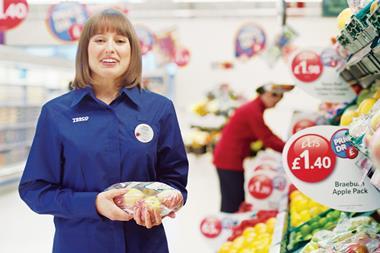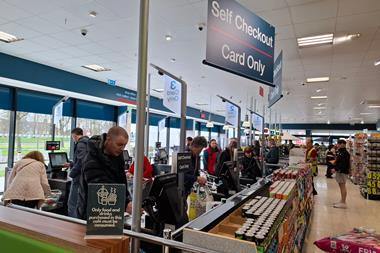The expansion of the major supermarket chains, the tactics employed, and the secrecy that surrounds property landbanks have always been controversial.
Only this week, Tesco was accused of buying up a town centre development in Linwood, Scotland, and allowing the site to become derelict, so it could secure a landmark regeneration deal.
But as The Grocer reported last week, Tesco has recently been vigorously pumping up its pipeline, with a flurry of new planning approvals granted, attracting a very different form of controversy.
In spite of its presence in every postcode in the UK, planning approvals for new Tesco stores, refits or extensions are already up 35% in value, to £467m in the year-to-date, or £571m including warehouses and distribution centres and accounted for almost 60% of total retail sales planning approvals in the market, according to figures from retail analysts Glenigan.
“Some of the pipeline network might not go through to development, but there are signs that a large amount will,” says Glenigan economist James Abraham.
With the Competition Commission inquiry complete, it has been suggested that normal service has resumed, but Tesco has not exactly been twiddling its thumbs. Sites already under construction, including new builds and extensions, are already up 51%, leaving Sainsbury’s (up 20%) and its nearest rivals trailing in its wake (strip out Tesco’s construction projects and the 7% overall growth would be in negative territory).
And while Sainsbury’s has awarded new contracts totalling £157m this year, up 29%, as it follows through on an ambitious plan to expand beyond its heartland in the south east, Tesco construction contracts dwarf this figure, up 20% to £245m. Once again, without Tesco’s chequebook, the 5% growth in retail construction contracts issued since the start of the year would be down overall.
So why is Tesco so bullish? How does it hope to benefit in a market where it appears to have so few holes to plug in its geographic coverage? And can this big expansion play lead to anything other than sales and profit cannibalisation for the UK’s biggest retailer?
On the evidence to date, with Tesco reporting sales up only 0.1% in the three months to May after the hike in VAT has been stripped out, Tesco’s continuing expansion and the current economic climate may already be harming top-line growth.
That’s the view of Evolution Securities analyst Dave McCarthy, at least. He was “astonished” when Tesco unveiled its plans for accelerated openings for 2010. In April Tesco stated it would invest £1.6bn of capital in the UK, opening a net 2.4 million sq ft of new space (well over 7% extra capacity). “Much is talked about Tesco expanding internationally but the UK remains the biggest consumer of capex for new Tesco space. This year’s opening programme is the biggest ever.”
The expansion figures for the grocery retailers in general is also “spectacular”, and goes way beyond a “space race”, he says.
“By the time the next World Cup comes around, the big four will have opened more space than Asda’s current estate. There is a capital war going on, with all the retailers scared to blink.
“Capacity is growing faster than the market and there is little soft market share left. UK food retailing is going to have to accept a fall in returns while this amount of space is being brought on stream.”
McCarthy’s view is not universally shared, of course. Verdict senior analyst Malcolm Pinkerton believes the tough market is forcing supermarkets to increase roll-out as like-for-like sales growth is so hard to come by. “The market isn’t growing at the same rate as it was in previous years. The only way to grow is to take share from rivals, even if they cannibalise their own sales to achieve this.”
But supermarkets believe they are better off having two stores in an area than allowing another chain in, he adds. “Although costs will go up relative to the sales they are generating, it’s a worthwhile pursuit.”
Pinkerton’s view is shared by CACI consulting partner of location strategy Paul Langston. “If a supermarket chain can steal from another they will do,” he says.
Langston believes there are a lot of gaps to be filled before the market reaches saturation point. Some of these are obvious.
“Morrisons is looking at the south while Sainsbury’s is looking north of the border. It really is dependent on the individual retailer,” he says.
The supermarkets are also using smaller formats not only to fill in gaps but as a tactical weapon to discourage rivals from entering a well-established patch. In April, Tesco revealed plans to open 181 Express and 32 One Stop stores by February 2011. Sainsbury’s its closest rival in the expansion game plans 75 c-stores in 2010/2011 and is on track to add 2.5 million sq ft, or 15%, of gross new space growth in two years to March 2011.
Another opportunity identified by the major multiples has been expansion in the market for supermarkets of 10,000 sq ft to 15,000 sq ft. Initially, this trend was identified in the enforced sell-off of certain Somerfield stores following The Co-operative Group’s acquisition; but Asda’s recent £778m deal to convert Netto stores continues the expansion trend.
Non-food is another hot area driving many of the extensions on existing sites, adds Pinkerton.
But McCarthy calls the non-food argument a “red herring” perpetuated by supermarkets to ensure they are “distracting” people from the real picture. “Around 75% of the 5m sq ft of new space being opened by the big four this year will be in traditional/core markets.”
The big four are being forced to continue with expansion as no supermarket is willing to buckle first and hand over market share to one of its rivals, he says. “It is a case of damned if they do and damned if they don’t.
“But what is rational behaviour for each individual company is irrational for the industry.”
Read more
Tesco shrugs off criticism in Scots property row (1 September 2010)
Sign in to comment on this article
Not logged in before? Register for FREE guest access today.
You will be able to:
- Read more stories
- Receive daily newsletters
- Comment on stories
Advert



















No comments yet